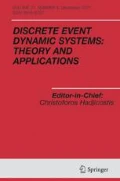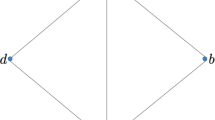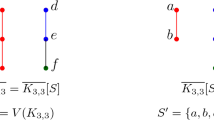Abstract
Karp and Miller’s algorithm is based on an exploration of the reachability tree of a Petri net where, the sequences of transitions with positive incidence are accelerated. The tree nodes of Karp and Miller are labeled with ω-markings representing (potentially infinite) coverability sets. This set of ω-markings allows us to decide several properties of the Petri net, such as whether a marking is coverable or whether the reachability set is finite. The edges of the Karp and Miller tree are labeled by transitions but the associated semantic is unclear which yields to a complex proof of the algorithm correctness. In this work we introduce three concepts: abstraction, acceleration and exploration sequence. In particular, we generalize the definition of transitions to ω-transitions in order to represent accelerations by such transitions. The notion of abstraction makes it possible to greatly simplify the proof of the correctness. On the other hand, for an additional cost in memory, which we theoretically evaluated, we propose an “accelerated” variant of the Karp and Miller algorithm with an expected gain in execution time. Based on a similar idea we have accelerated (and made complete) the minimal coverability graph construction, implemented it in a tool and performed numerous promising benchmarks issued from realistic case studies and from a random generator of Petri nets.



Similar content being viewed by others
Notes
http://www.cprover.org/bfc/.(Kaiser et al. 2014)
http://mjolnir.cs.ox.ac.uk/soter/(D’Osualdo et al. 2013)
References
Blondin M, Finkel A, Haase C, Haddad S (2017) The logical view on continuous Petri nets. ACM Trans Comput Logic (TOCL) 18(3):24:1–24:28
Blondin M, Finkel A, McKenzie P (2017) Well behaved transition systems. LMCS 13(3):1–19
D’Osualdo E, Kochems J, Ong CHL (2013) Automatic verification of Erlang-style concurrency. In: Static Analysis, pp 454–476
Esparza J, Ledesma-Garza R, Majumdar R, Meyer P, Niksic F (2014) An smt-based approach to coverability analysis. In: CAV, pp 603–619
Alain F (1990) Reduction and covering of infinite reachability trees. Inf Comput 89(2):144–179
Finkel A (1993) The minimal coverability graph for Petri nets. In: Advances in petri nets 1993, volume 674 of lecture notes in computer science,. Springer, pp 210–243
Finkel A, Geeraerts G, Raskin J-F, Van Begin L (2005) A counter-example the the minimal coverability tree algorithm. Technical Reportm, 535, Université Libre de Bruxelles, Belgium
Finkel A, Goubault-Larrecq J (2012) Forward analysis for WSTS, part II: Complete WSTS. LMCS, 8(4)
Finkel A, Haddad S, Khmelnitsky I (2020) Minimal Coverability Tree Construction Made Complete and Efficient. In https://hal.inria.fr/hal-02479879/
Geeraerts G, Raskin J-F, Van Begin L (2010) On the efficient computation of the minimal coverability set of Petri nets. Int. J. Found Comput Sci 21 (2):135–165
Hack M (1976) Decidability questions for Petri Nets. PhD thesis, Massachusetts Institute of Technology, Cambridge, MA USA
Kaiser A, Kroening D, Wahl T (2014) A widening approach to multithreaded program verification. ACM Trans Program Lang Syst 36(4)
Karp RM, Miller RE (1969) Parallel program schemata. J Comput Syst Sci 3(2):147–195
Kloos J, Majumdar R, Niksic F, Piskac R (2013) Incremental, inductive coverability. In: CAV, pp 158–173
Leroux J (2019) Distance between mutually reachable petri net configurations. In: FSTTCS 2019, pp 47:1–47:14
Piipponen A, Valmari A (2016) Constructing minimal coverability sets. Fundamenta Informaticae 143(3–4):393–414
Reynier P-A, Servais F (2013) Minimal coverability set for Petri nets: Karp and Miller algorithm with pruning. Fundamenta Informaticae 122(1–2):1–30
Valmari A, Hansen H (2014) Old and new algorithms for minimal coverability sets. Fundamenta Informaticae 131(1):1–25
Yamamoto M, Sekine S, Matsumoto S (2017) Formalization of karp-miller tree construction on petri nets. In: Proceedings of the 6th ACM SIGPLAN conference on certified programs and proofs, CPP 2017. ACM, pp 66–78
Acknowledgments
The authors would like to thank the reviewers for their careful reading of the article and their constructive comments that help us to improve the quality of our article.
Author information
Authors and Affiliations
Corresponding author
Additional information
Publisher’s note
Springer Nature remains neutral with regard to jurisdictional claims in published maps and institutional affiliations.
This article belongs to the Topical Collection: Topical Collection on Recent Trends in Reactive Systems
Guest Editor: Sebastian Lahaye
Rights and permissions
About this article
Cite this article
Finkel, A., Haddad, S. & Khmelnitsky, I. Commodification of accelerations for the Karp and Miller Construction. Discrete Event Dyn Syst 31, 251–270 (2021). https://doi.org/10.1007/s10626-020-00331-z
Received:
Accepted:
Published:
Issue Date:
DOI: https://doi.org/10.1007/s10626-020-00331-z




